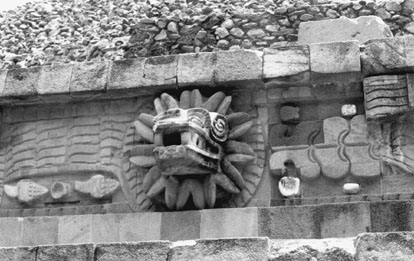

 | Page 557 |  |
on which his thesis was based. He also made some preliminary nonstratigraphic excavations at Azcapotzalco in western mexico, where he tried to associate the materials he obtained with indigenous groups from the fifteenth and sixteenth centuries.

Temple of the Feathered Serpent at Teotihuacán, the subject of Manuel Gamio’s major archaeological project in the 1920s
(Photo by Kay A. Read)
In 1909, Gamio received a scholarship to study anthropology at Columbia University in New York City, where the anthropologist professor Franz Boas was to become his friend and collaborator on a number of archaeological and anthropological programs. In 1912, Gamio returned with his M.A. to Mexico City and began working with the newly founded International School of American Archaeology and Ethnography, excavating once more at Azcapotzalco. His exploration of the mound at San Miguel Amantla in 1913 was the first stratigraphic excavation in North America, and the culture sequence of archaic (formative)/teotihuacán/aztec that he identified was correctly ordered (if incomplete), as has been demonstrated by subsequent stratigraphic work in the basin of Mexico. In 1914, Gamio described the stratigraphic technique in the manual “Methodology Concerning the Investigation, Exploration, and Conservation of Archaeological Monuments” published in the Anales of the National Museum. In the same year, he published a report on his excavations of the main plaza of tenochtitlán, the Aztec capital, in the center of Mexico City.
In 1916, Gamio became the director of the International School of American Archaeology and Ethnography, and there he produced important studies in archaeology, ethnology, and linguistics. In the same year, he also published an influential collection of essays on the political and social problems of Mexico, Founding the Fatherland, which included proposals for improving the lives of indigenous peoples. The work inspired many revolutionary intellectuals and political leaders, including two presidents of Mexico, Venustiano Carranza (1911–1914) and Alvaro Obregon (1920–1924). During the subsequent civil war, Gamio openly supported Emiliano Zapata, the revolutionary leader most concerned with the problems of Indian groups, an unpopular stance to take in Mexico City, where Gamio was surrounded by politicians and generals who did not share his views.
 |  |